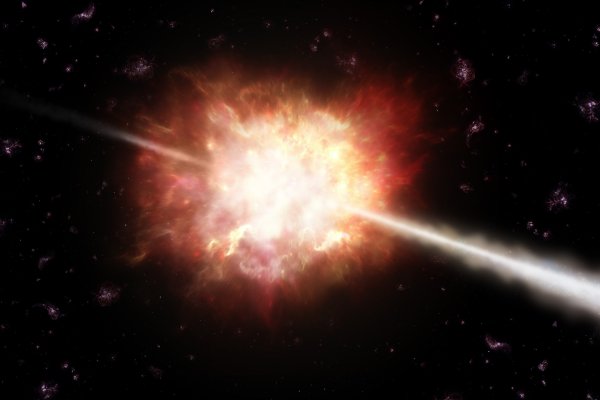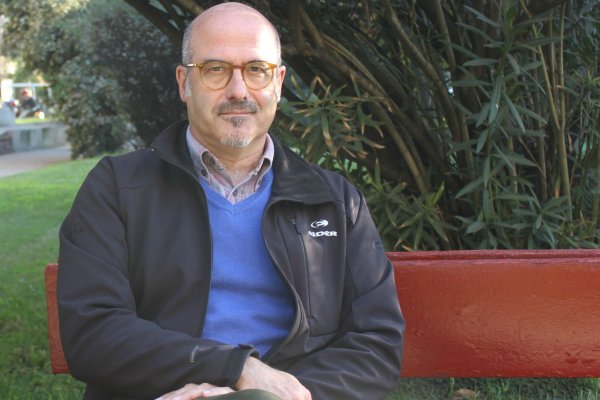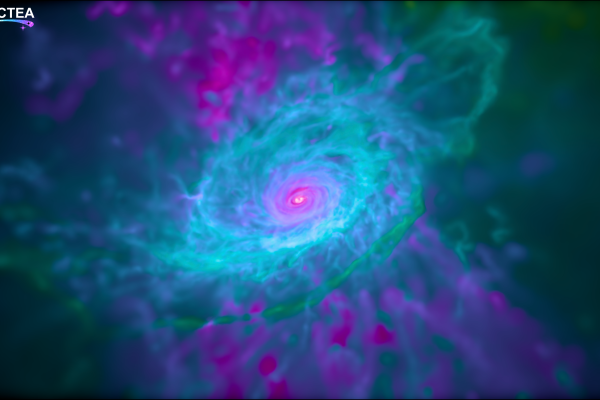An international team of scientists has announced groundbreaking observations of the brightest gamma-ray burst (GRB) ever recorded, GRB 221009A. The findings, published today in The Astrophysical Journal Letters, provide the strongest evidence yet for the existence of complex, structured jets in long-duration GRBs, cosmic explosions among the most powerful events in the Universe.
The researchers are members of the CTAO LST Collaboration, a global scientific project dedicated to advancing very-high-energy gamma-ray astronomy. The Collaboration brings together experts from over 11 countries to design, build, and operate the Large-Sized Telescopes (LSTs) of the Cherenkov Telescope Array Observatory (CTAO), the next-generation facility for exploring the most extreme phenomena in the Universe.
GRB 221009A, dubbed the “BOAT” (Brightest Of All Time), was first detected on October 9, 2022, by space-based observatories including NASA’s Fermi and Swift satellites. The burst was so intense that it saturated detectors and triggered follow-up observations across the globe.
The LST-1 telescope, located at the CTAO’s northern site in La Palma, began observing the event just 1.33 days after the initial explosion—making it the earliest ground-based observations of very-high-energy gamma rays from this event by an imaging atmospheric Cherenkov telescope. These instruments detect gamma rays indirectly by capturing the brief flashes of light produced when these rays interact with the Earth’s atmosphere. Despite challenging conditions due to moonlight, the team was able to record an excess of gamma-ray events from GRB 221009A, making it a rare and valuable finding in this energy range.

A new window into Cosmic Jet physics
What makes this discovery particularly exciting is its contribution to our understanding of GRBs, how they operate and emit such colossal amounts of energy. The data from LST-1 support the theory that GRB 221009A was powered by a structured jet, a narrow, ultra-fast core surrounded by a slower, wider wing. This contrasts with the simpler “top-hat” jet models commonly used to describe GRBs.
“GRB 221009A provides strong evidence for a structured jet in long GRBs” said Arnau Aguasca-Cabot, predoctoral researcher at the Institute of Cosmos Sciences of the University of Barcelona (ICCUB) and the Institute of Spaces Studies of Catalonia (IEEC) and coordinator of the study. “its detection has significant implications for theoretical models of jets.”
The LST-1 observations also help distinguish between competing theoretical models. Some predicted much higher very-high-energy gamma-ray emission than was observed. The new data rule out those models, narrowing the field and guiding future research.
“Unique events like this GRB, which challenge theoretical models, may reveal insights into the unknown nature of the central engine powering this cosmic jet", said Pol Bordas, ICCUB-IEEC researcher and co-author of the study.
A Milestone for the CTAO and High-Energy Astrophysics
This campaign marks the most extensive GRB follow-up ever conducted by LST-1, spanning over 20 days. It also demonstrates the telescope’s ability to operate under moonlight conditions—an important step in increasing the observatory’s responsiveness to transient cosmic events.
“We conducted the first analysis under moonlight conditions, setting a key precedent for rapid follow-up of transient events when timely data collection is critical”, said Monica Seglar Arroyo, IFAE researcher and coordinator of the study.
These results highlight the power of the CTAO’s next-generation telescopes to explore the high-energy Universe, since we’re entering a new era where we can probe the inner workings of cosmic explosions in unprecedented detail.
As the CTAO continues to expand, with more telescopes becoming operative in both hemispheres, scientists anticipate even more rapid and sensitive observations of GRBs and other extreme phenomena.
About the LST
The Large-Sized Telescopes (LSTs) are one of the three types of telescopes that the CTAO will use to cover its broad energy range, from 20 GeV to 300 TeV. When gamma rays interact with Earth’s atmosphere, they generate cascades of particles that produce Cherenkov light. Because lower-energy gamma rays create only small amounts of Cherenkov light, telescopes with large collection areas are needed to detect it. The LST, with its 23-meter diameter dish, will provide the CTAO’s unique sensitivity in the low-energy range between 20 and 150 GeV.
Despite standing 45 meters tall and weighing 100 tonnes, each LST can reposition to any point in the sky within 20 seconds. Both this rapid repositioning and the low-energy threshold of the LSTs are critical for the CTAO’s studies of galactic transients, high-redshift active galactic nuclei, and gamma-ray bursts.
The CTAO LST Collaboration, responsible for designing and building these telescopes, is making rapid progress on the CTAO-North site in La Palma, Spain. In 2018, the LST prototype, LST-1, was inaugurated and has been under commissioning since then. Currently, three additional LSTs are under construction and are expected to be complete by spring 2026.
About the CTAO
The CTAO (Cherenkov Telescope Array Observatory; www.ctao.org) will be the world’s largest and most powerful observatory for gamma-ray astronomy. The CTAO’s unparalleled accuracy and broad energy range (20 GeV- 300 TeV) will help to address some of the most perplexing questions in astrophysics, falling under three major themes: understanding the origin and role of relativistic cosmic particles; probing extreme environments, such as black holes or neutron stars; and exploring frontiers in physics, searching for dark matter or deviations from Einstein’s theory of relativity. Additionally, the CTAO will play a key role in both multi-wavelength and multi-messenger fields in the coming decades thanks to its enhanced performance, which will allow it to provide fundamental gamma-ray information in the quest to probe the most extreme scenarios.
To cover its broad energy range, the CTAO will use three types of telescopes: the Large-Sized Telescopes (LST), the Medium-Sized Telescopes (MST) and the Small-Sized Telescopes (SST). More than 60 telescopes will be distributed between two telescope array sites: CTAO-North in the northern hemisphere at the Instituto de Astrofísica de Canarias’ (IAC’s) Roque de los Muchachos Observatory on La Palma (Spain), and CTAO-South in the southern hemisphere at the European Southern Observatory’s (ESO’s) Paranal Observatory in the Atacama Desert (Chile). The Headquarters of the CTAO is hosted by the Istituto Nazionale di Astrofisica (INAF) in Bologna (Italy), and the Data Management Centre (SDMC) Data Management Centre (SDMC) is hosted by the Deutsches Elektronen-Synchrotron DESY in Zeuthen (Germany).
The CTAO is a Big Data project. The Observatory will generate hundreds of petabytes (PB) of data in a year (~12 PB after compression). Based on its commitment to open science, the CTAO will be the first gamma-ray observatory of its kind to operate as an open, proposal-driven observatory providing public access to its high-level science data and software products.
In January 2025, the CTAO was established as a European Research Infrastructure Consortium (ERIC) by the European Commission. The Founding Members of the CTAO ERIC are Austria, the Czech Republic, the European Southern Observatory (ESO), France, Germany, Italy, Poland, Slovenia, and Spain. Additionally, Japan is a Strategic Partner, and the accession of Switzerland and Croatia as Founding Members is being processed.
The CTAO ERIC, commonly referred to as the CTAO Central Organisation, is in charge of the construction and operations of the Observatory. This group works in close cooperation with partners from around the world toward the development of the Observatory. Major partners include In-Kind Contribution Collaborations that are developing essential hardware and software, in addition to the CTAO Consortium, an international group of researchers who works in the scientific exploitation of the Observatory.
Reference
K. Abe et al. (2025). GRB 221009A: Observations with LST-1 of CTAO and implications for structured jets in long gamma-ray bursts. The Astrophysical Journal Letters. https://doi.org/10.3847/2041-8213/ade4cf
Media Contact:
Prof. Masahiro Teshima
LST Principle Investigator (PI)
mteshima@icrr.u-tokyo.ac.jp
(English, Japanese)
LST Outreach Team
lst-outreach@cta-observatory.org
(English, Spanish, German and Croatian)
Dr. Alba Fernández-Barral
CTAO Outreach, Education and Communication Officer
alba.fernandezbarral@cta-observatory.org
+39-051-6357-270
(English, Spanish and Italian)



